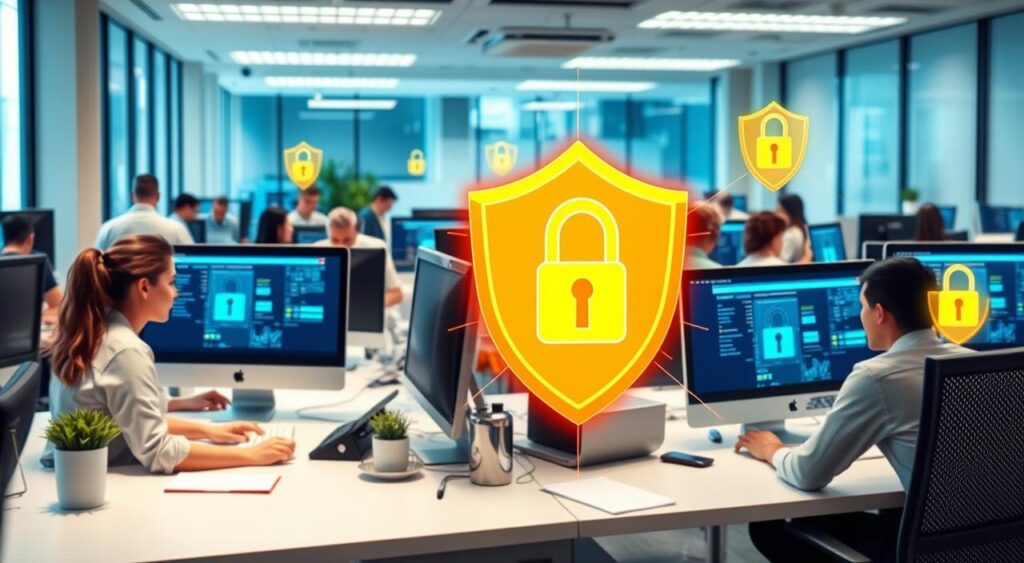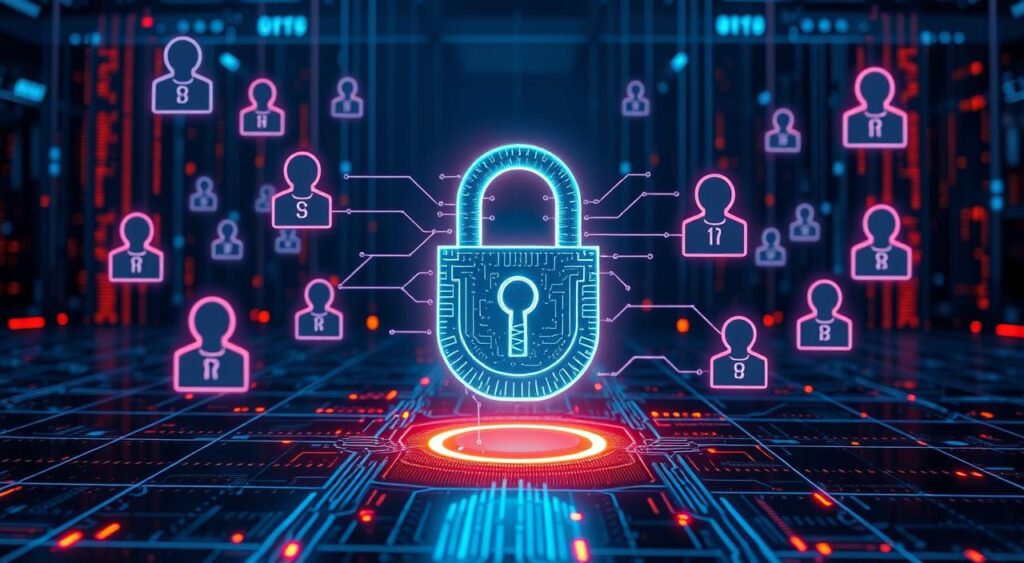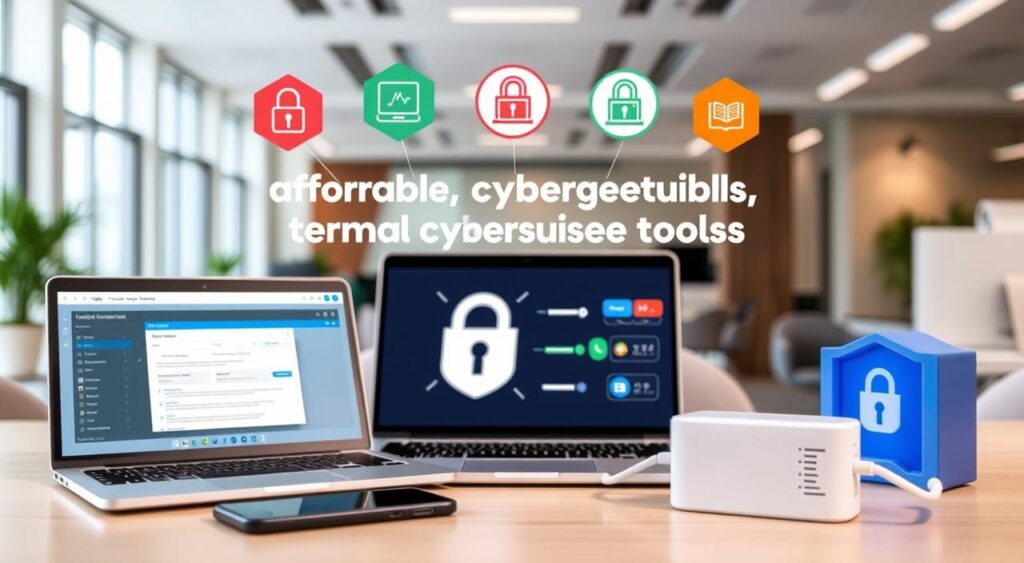
Small businesses face many cybersecurity threats today. These include data breaches, ransomware, phishing, and network attacks. But, the right cybersecurity software can protect your business. We’ll look at the top options to help you keep your data safe.
Key Takeaways
- Small businesses are common targets for cybercriminals due to vulnerabilities in server applications and operating systems.
- Comprehensive cybersecurity solutions can protect against a wide range of digital threats, including malware, data breaches, and phishing attacks.
- Cloud-based security platforms offer scalable, cost-effective solutions for small businesses with limited IT resources.
- Endpoint detection and response (EDR) tools provide advanced threat detection and real-time monitoring to identify and respond to security incidents.
- Investing in robust cybersecurity measures is crucial for small businesses to maintain operations, protect sensitive information, and build customer trust.
Understanding Modern Cybersecurity Challenges for SMBs
Small and medium-sized businesses (SMBs) are facing more cybersecurity threats as they go digital. Ransomware, phishing, and hacking are common, threatening their finances, customer trust, and business survival. In fact, 88% of small business owners think their company is at risk of a cyber attack.
Common Cyber Threats Targeting Small Businesses
Social engineering is a big threat to SMBs, making up about 97% of cyber threats. This includes phishing, where attackers trick employees into sharing sensitive info. With more people working from home, “Zoom-bombing” or hijacking video calls has also increased.
Impact of Security Breaches on Business Operations
Security breaches can severely harm small businesses. The Small Business Administration says small businesses make up 49.2% of U.S. private-sector jobs. Cyber attacks can damage their finances, erode customer trust, and weaken their operations.
Current Cybersecurity Landscape Statistics
The cybersecurity situation for SMBs is concerning. Only 17% of SMBs think their cybersecurity skills are effective. Meanwhile, 55% find them ineffective. Between 2014 and 2019, BEC scams cost over $2.1 billion, using cloud-based email services.
| Cybersecurity Challenge | Impact |
|---|---|
| Perceived cost of cybersecurity solutions | Barrier to SMBs implementing robust security measures |
| Lack of understanding of cyber risks | Hinders SMBs from prioritizing cybersecurity |
| Competing business priorities | Cybersecurity often takes a backseat to other operational concerns |
| Lack of SMB-focused solutions and incentives | SMBs struggle to find affordable and accessible cybersecurity tools |
| Lack of employee awareness training | Increases vulnerability to social engineering attacks |
The Cyber Readiness Institute (CRI) urges a big increase in incentives for SMBs. They want more support from insurers, organizations, and government agencies at all levels.
Essential Components of Small Business Cybersecurity
Small businesses face many cyber threats today. They need a strong defense that covers all bases. This defense includes key parts that protect data and fight off malware.
Antivirus software is a must-have. It scans for and blocks many types of malware. Next-generation firewalls (NGFWs) also play a big role. They offer strong security and help create safe VPNs for online communication.
- Domain Name System (DNS) protection adds an extra layer of defense by preventing access to dangerous websites, effectively blocking many web-based threats.
- Email gateway security is essential, as it helps filter out spam and malware-containing emails, reducing the risk of phishing attacks and unauthorized access to business data.
Using antivirus software, firewalls, DNS protection, and email gateway security is key. These tools help keep small businesses safe from cyber threats. They protect valuable data and keep operations running smoothly.
“A robust cybersecurity infrastructure is particularly crucial for small businesses due to their vulnerability compared to larger enterprises that have advanced security measures in place.”
As cyber threats grow, small businesses must stay alert and act fast. By focusing on these key components, they can strengthen their defenses. This helps protect against malware and other online dangers.
Best Cybersecurity Software for Small Businesses
Small businesses face many cybersecurity threats. They need strong defense solutions to protect themselves. Top tools include Endpoint Detection and Response (EDR), Next-Generation Firewalls (NGFWs), and email gateway security.
Endpoint Detection and Response (EDR) Solutions
EDR software is key in fighting threats on devices connected to networks. A study found that EDR solutions cut down response times by 70%. They watch devices, check behavior, and quickly stop threats. This makes them crucial for small businesses to fight ransomware and viruses.
Next-Generation Firewalls (NGFW)
NGFWs offer better protection by checking data packets and using machine learning. They go beyond old firewalls by inspecting packets deeply, controlling apps, and stopping intrusions. This makes them a strong choice for small businesses to protect their networks.
Email Gateway Security Platforms
Email gateways are vital in keeping out unwanted emails, a common threat for small businesses. They use advanced methods like spam and malware scanning, and phishing detection. This helps small businesses keep their emails safe and avoid cyber threats.
Other great cybersecurity software for small businesses include Rippling IT, New Relic, Aikido Security, ManageEngine Endpoint Central, and ESET PROTECT Complete. Each has special features and prices for small and medium-sized businesses.
As cybersecurity changes, small businesses should invest in these strong software solutions. They help protect against ransomware and viruses. This lets small businesses stay safe and keep running, even with today’s cyber threats.
Advanced Network Protection Tools
Small businesses face many cyber threats. They need strong network protection tools to keep their data safe. Intrusion Detection and Prevention Systems (IDS/IPS) are key in fighting off bad activities. They check data packets and stop threats right away.
Logging and log monitoring are also vital for small business security. They give detailed info on network activity. This helps spot threats and understand breaches.
Web Application Firewalls (WAFs) protect web apps from hackers and DDoS attacks. They keep online resources safe and working well.
Software-defined wide-area networks (SD-WAN) give small businesses control over their network. They manage traffic better, making networks more secure and efficient.
Using these tools, small businesses can fight off many cyber threats. They keep their data safe and keep their business running smoothly.
“Implementing comprehensive network protection solutions is a critical step for small businesses to safeguard their digital assets and ensure resilience against cyber threats.”
Cloud-Based Security Solutions for SMBs
Small and medium-sized businesses (SMBs) face a big challenge in keeping their data safe. Cloud-based security solutions are a strong defense against cyber threats. They offer a flexible and powerful way to protect against attacks.
Data Protection in Cloud Environments
Cloud security is key to keeping data safe in the cloud. It uses top-notch encryption and access controls. This way, SMBs can be sure their data is protected from hackers and breaches.
Cloud Security Best Practices
Using cloud security means following best practices. This includes strong passwords, updating security often, and watching for threats. By being proactive, SMBs can keep their cloud data safe.
Integration with Existing Systems
It’s important for cloud security to work with what SMBs already have. It should fit with their current systems and apps. This way, SMBs can use what they have and get new security benefits.
Cloud security is a smart choice for SMBs to fight cyber threats. By focusing on data safety, following best practices, and integrating with current systems, SMBs can protect their business in the digital world.
Authentication and Access Management Software
Securing small business networks and protecting sensitive data is key today. Authentication and access management software are crucial. They stop unauthorized access and control user actions. These tools let us give and take away access easily, keeping our most important data safe.
Enterprise password management and Privileged Access Management (PAM) are vital for small business security. They manage user identities and activities, giving the right access based on role. Strong authentication, like multi-factor, lowers the risk of weak or stolen passwords.
Virtual Private Networks (VPNs) add security by encrypting data between users and our network. This encryption protects sensitive info, even when accessed from afar. It keeps our small business safe from data breaches and cyber threats.
One Identity’s 2022 Identities and Security Survey found 89% of respondents faced identity-based attacks. 80% think better identity management tools could have stopped many. IAM solutions help avoid weak passwords, lowering risks.
Many industries have strict data security and privacy rules (like GDPR, HIPAA, and SOX). IAM solutions help meet these standards with reliable access logs and controls. The need for IAM has grown for better security, compliance, and user experience.
| IAM Solution | Key Features |
|---|---|
| Okta IAM | Single sign-on, multi-factor authentication, lifecycle management, API access management, and integration capabilities |
| Microsoft Entra IAM | Privileged identity management, identity governance, unified login, and dual-layer security |
| Zluri | Zero-touch provisioning, seamless integration with identity providers, HRMS, SCIM and non-SCIM apps, and ITSM tools |
Using authentication and access management software boosts our small business network security. It also ensures strong data protection for our organization.

Threat Detection and Response Systems
As cyber threats grow, small businesses must focus on threat detection and response. Malware protection for small firms and ransomware defense for small enterprises are key. Unprotected SMBs are often targeted by advanced cyber attacks.
Real-time Monitoring Solutions
Real-time monitoring is crucial for spotting and stopping security risks. These systems check network activity, user behavior, and endpoint data for signs of malware or ransomware. They give SMBs the power to act fast and protect their IT infrastructure.
Incident Response Capabilities
Incident response tools help small businesses handle security issues quickly. When a threat is found, these tools can isolate affected areas, remove malware, and start fixing problems. This helps SMBs deal with cyber attacks and prevent future ones.
Security Analytics Tools
Security analytics use advanced data analysis to find security risks. These tools gather data from different sources to give a full view of security. They help SMBs find hidden threats and improve their cybersecurity.
| Solution | Key Features | Benefits for SMBs |
|---|---|---|
| Managed Detection and Response (MDR) |
|
Comprehensive security management without the need for in-house expertise |
| Endpoint Detection and Response (EDR) |
|
Proactive protection against known and unknown threats |
| Threat Intelligence Platform |
|
Improved understanding and mitigation of emerging cyber threats |
| Security Information and Event Management (SIEM) |
|
Enhanced visibility, threat detection, and compliance for regulated industries |
By using these threat detection and response systems, small businesses can protect themselves from malware protection small firms and ransomware defense small enterprises challenges.
Budget-Friendly Security Solutions
Small and medium-sized enterprises (SMEs) face a big challenge in the world of cybersecurity. They need to find affordable ways to protect themselves. Luckily, there are many cost-effective options that offer strong security without spending too much.
Cloud-based security services are a smart choice for SMEs. They are affordable and can grow with your business. Many providers offer all-in-one security packages at a good price.
Open-source security tools are also worth looking into. They might need more work, but they’re free or very cheap. Some commercial software offers free versions that can help you get started without spending a lot.
When picking a budget-friendly security solution, think about the total cost. Look out for hidden fees for extra features or support. By matching your needs with the right budget option, SMEs can find a balance between cost and security.
| Vendor | SecurityScore | Pricing |
|---|---|---|
| ADT | 9.8 | Packages start at $599, with monitoring from $25/month |
| Vivint | 9.4 | High-end solutions tailored for small and large businesses |
| SimpliSafe | 9.2 | Affordable and scalable security options for businesses |
By using these affordable cybersecurity tools, SMEs can boost their security. They can protect themselves from cyber threats without spending too much.

Conclusion
Protecting our small businesses from cyber threats is crucial. By using cybersecurity solutions SMBs, we can keep our digital assets safe. This helps us keep our customers’ trust and ensures our success.
There are many ways to protect ourselves, like endpoint protection and network security. Cloud-based solutions and threat detection are also important. The top security software small companies use helps us stay ahead.
Regular risk assessments and employee training are key. Using the latest security tools is also essential. This way, we can fight off malicious actors and protect our businesses.
As cybersecurity changes, staying informed and proactive is vital. By choosing the right cybersecurity solutions SMBs, we can make our businesses strong. This sets us up for growth and success in the digital world.




